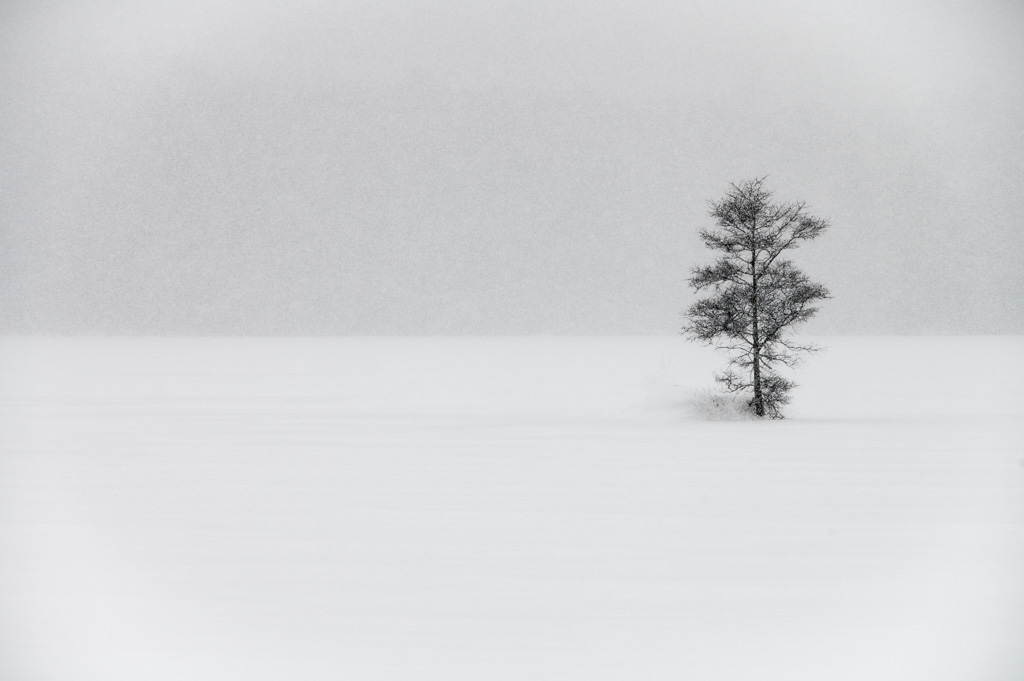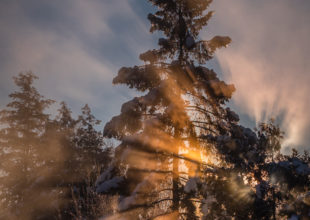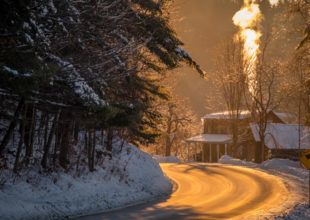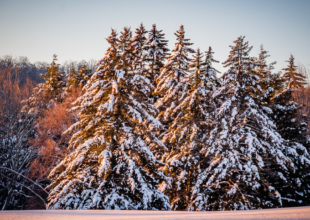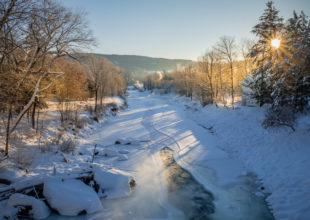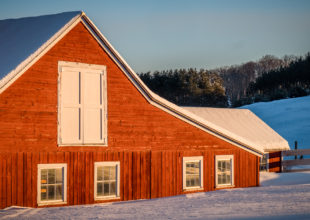All Vermont winters are cold, some are colder than others. The recent cold snap during the last week of 2017 and the first week of 2018 was particularity brutal – even by Vermont standards. Morning temperatures routinely hovered around -15°F to -22°F in the Connecticut River Valley region of Vermont. Frigid cold is equally tough on photographer and equipment. Photographing in these conditions requires careful thought and ample preparation. The fact that these conditions create special difficulties is not news to anyone, however, there are tips that often get overlooked. Any misstep and you can waste the entire photo excursion.
Good landscape photography requires a healthy dose of patience. A good chunk of your time is waiting around for something to happen. This is true even in the bone-chilling cold. Mother Nature is not going to speed up the sunrise because you are cold. Making sure you are safe and warm in sub-zero temperatures becomes job one and there are no secrets here. Dress in layers at least three deep. You need to minimize exposed skin especially your face. The first place you will feel the cold’s effects is going to be your hands (fingers), feet (toes), and ears. Keeping your fingers warm and free to control your camera and lens can be tricky. More than one winter photo excursion has become short-lived by ignoring these essential body parts. If you regularly photograph in winter invest in some commercially reusable hand and boot warmers. There are other items of importance that deserve your attention. If you are venturing out solo be sure to let others know the locations you plan to visit. Try to stay in (or close too) cell service range if possible. Make sure your vehicle is up to the task. The last thing you need is a breakdown or dead battery far from cell service when the temperature is 15 or 20 degrees below zero. Your vehicle is your sole source of heat. Lose that source in sub-zero temperatures and you have maybe 30 minutes to do something about it. If you are with multiple photographers in multiple vehicles then you can venture a little farther and assume a little more risk. If you are not using a vehicle and are camping and hiking then this article is not for you, since you would know most of this already. Take care of yourself and your images will be better for it. A rushed photographer very rarely gets good shots.
Assuming you have properly prepared yourself you can then turn your attention to your equipment. A good dose of planning is helpful here too. Prior to leaving, you should plan the days events, even write them down. This will help you determine the days necessary equipment. Take a minimum amount of equipment, only use the bare essentials needed. Leaving unused equipment in a camera bag in your vehicle is asking for trouble. The main goal in this weather is to keep moisture away from the equipment. This means that you can not keep your vehicle too warm. Jumping in and out of a warm vehicle into sub-zero temperatures will cause condensation to build inside your equipment causing fatal damage. The greatest source of damaging moisture may be surprising one, because it’s you, actually your mouth specifically. In the bitter cold, every time you exhale around your camera or lens you are providing moisture that will immediately freeze on your equipment. Hold your breath when close to the camera and step away before exhaling. Most companies sell cameras and lenses that are weather sealed, a very important feature for these conditions.
Keeping things simple makes sense in cold weather. You should try and use only one camera body and one lens. If you are going to use multiple camera bodies, attach the lens you wish to use with that body before venturing outdoors. Changing lenses in the field needlessly exposes the inside of your camera to the harsh elements. The one camera – one lens rule will minimize accidents. Carrying more equipment means a greater chance of dropping something. Getting snow off equipment in sub-zero temperatures is tough. You need to give some thought to handling anything that is metal, mainly your tripod. Find some way to insulate any metal. Touching metal in frigid temperatures is not something you will soon forget. Do not leave your tripod in your vehicle overnight, keep it with the rest of your equipment. It is just a delicate as the rest of your equipment to the nasty elements. I once had a tripod metal base split in half from the cold. It left me stranded (photographically speaking) in thigh-deep snow and bitter cold. Keep lots of snacks and drinks warm and close by, your body needs calories in the bitter cold. The internal furnace is working overtime to keep your insides and vital organs warm and functioning. Make sure you have the fuel it needs.
There are a few photo-taking tips that are particular to cold weather. Bracket your exposures, reviewing your photos and checking your histogram are not likely to happen when you are out in the elements. Outdoor time is precious, so take lots of exposures and weed out bad ones when back at the warmth of your computer. Keep your batteries warm as the cold drains batteries prematurely. It would help to keep them close to your body. Once your camera tells you it is drained, swap it out with a new one and take the drained battery and place it close to the warmth of your body, it will gain back some of its strength and become usable again. Be on the lookout for unique subjects. The bitterly cold winter landscape takes on a very distinctive personality. Be on the lookout for ice sickles, snow mounds, “smoke”, frozen mist and many other odd features of these conditions. Mother Nature will provide interesting subject matter and it will be uncomfortable but if you can find a way to deal with the discomfort you will be rewarded.
My most recent trip in the Vermont landscape I used a Fujifilm X-T2 camera body and a Fujifilm 50 -140mm F2.8 or the 10 -24mm F4 lens. All equipment worked flawlessly and performed well. I have attached some of the photos taken during my holiday week excursion. Stay warm.
